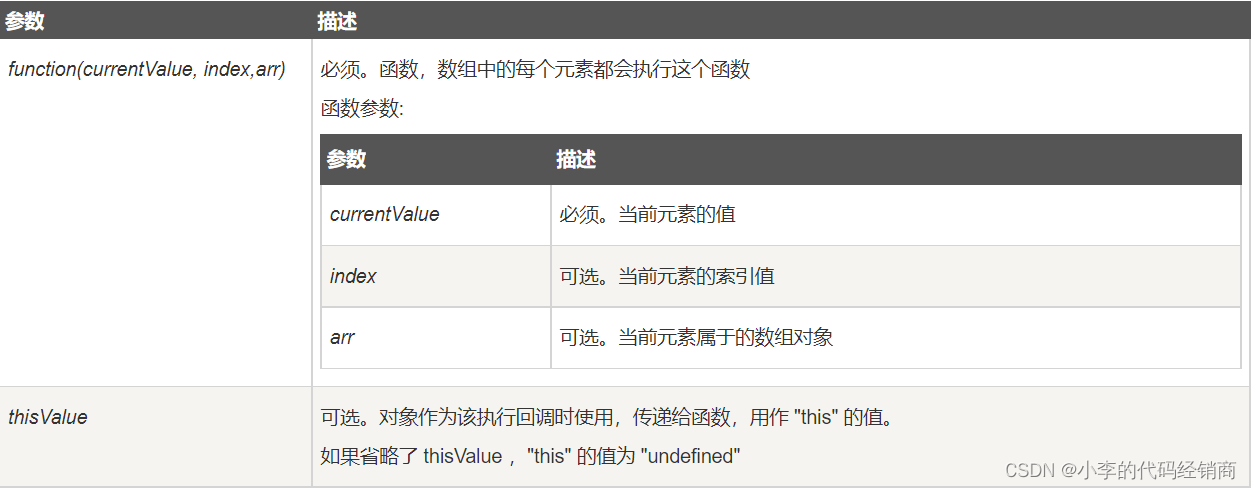数组中filter()方法总结
1.filter():创建一个新的数组,新数组中的元素是通过检查指定数组中符合条件的所有元素。
2.array.filter(function(currentValue,index,arr), thisValue);


3. filter() 方法用于把Array中的某些元素过滤掉,然后返回剩下的未被过滤掉的元素。
注意:
1、filter() 不会对空数组进行检测;
2、filter() 不会改变原始数组。
实例:
(1)返回数组array中所有元素都大于等于14的元素、返回等于14、返回大于某个值和小于某个值的元素。
const array = [14, 17, 18, 32, 33, 16, 40]; const newArr = array.filter(num => num > 14) console.log(newArr);//打印 [17,18,32,33,16,40] // 查找某个值------------------------- const array = [14, 17, 18, 32, 33, 16, 40]; const newArr = array.filter(num => num == 14) console.log(newArr);//打印 [14] //返回大于某个值和小于某个值的元素 const array = [14, 17, 18, 32, 33, 16, 40]; const newArr = array.filter(num => num > 14 && num < 33) console.log(newArr);//打印 [17, 18, 32, 16]
(2)数组去重操作:对数组array中所有相同的元素进行去重复操作。
const array = [2, 2, 'a', 'a', true, true, 15, 17] const newArr = array.filter((item, i, arr) => { return arr.indexOf(item) === i }) console.log(newArr);//打印 [2, 'a', true, 15, 17] //------------------------------------------------------------------------- const array = [1, 2, 3, 4, 5, 6, 7, 8, 9, 4, 5, 6, 7, 9,] const newArr = array.filter((item, i, arr) => { return arr.indexOf(item) === i }) console.log(newArr);// 打印 [1, 2, 3, 4, 5, 6, 7, 8, 9]
(3)数组中保留奇数或者偶数。
//保留偶数---------------------------------------- const array = [1, 2, 3, 4, 5, 6, 7, 8, 9, 10] const newArr = array.filter((item, i, arr) => { return item % 2 === 0 }) console.log(newArr);// 打印 [2, 4, 6, 8, 10] //保留奇数---------------------------------------- const array = [1, 2, 3, 4, 5, 6, 7, 8, 9, 10] const newArr = array.filter((item, i, arr) => { return item % 2 !== 0 }) console.log(newArr);// 打印 [1, 3, 5, 7, 9]
(4)去掉数组中的假值,比如:空字符串、undefined、null、0、false。
const array = [ { id: 3 }, { id: 4 }, { id: null }, { id: undefined }, { id: '' }, { id: 0 }, { id: false } ] const newArr = array.filter(({ id }) => id) console.log(newArr);// 打印 [{ "id": 3 },{ "id": 4 }] //------------------------------------------------------------------- const array = [undefined, null, 3, 5, 'a', false, 0] const newArr = array.filter(item => item) console.log(newArr);// 打印 [3, 5, 'a']
(5)把对象数组array中的某个属性值取出来存到数组newArr中。
const array = [ { name: "a", type: "letter" }, { name: '1', type: "digital" }, { name: 'c', type: "letter" }, { name: '2', type: "digital" }, ]; const newArr = array.filter((item, i, arr) => { return item.type === "letter" }) console.log(newArr); // 打印 [{ "name": "a", "type": "letter" }, { "name": "c", "type":"letter" }]
(6)filter结合find方法,实现两个数组的补集的解决方法,oldArr的元素newArr中都有,在newArr中去掉所有的oldArr。
//find() 方法返回数组中满足提供的测试函数的第一个元素的值。这里有四个元素,那么就会返回两个数组元素相等的值,这里取反就返回不相等的值,
//不取反的时候因为30的元素不符合,所以不返回30的值。 const array = [32, 4, 11, 55, 46, 99, 104, 54, 16, 33, 78, 43, 40] const oldArr = [32, 33, 16, 40, 30] function myfunction() { const result = array.filter(item1 => { //此处取反去掉,将变换元素状态 return !oldArr.find(item2 => { return item1 === item2 }) }) return result } const newArr = myfunction() console.log(newArr); // 取反打印 [4, 11, 55, 46, 99, 104, 54, 78, 43] // 不取反打印 [32, 16, 33, 40] 此处30的元素不符合,所以不返回30的值


